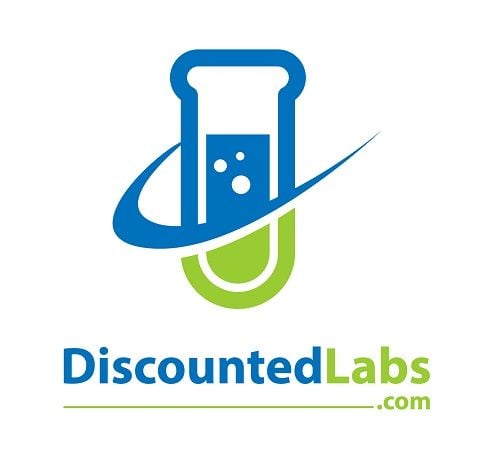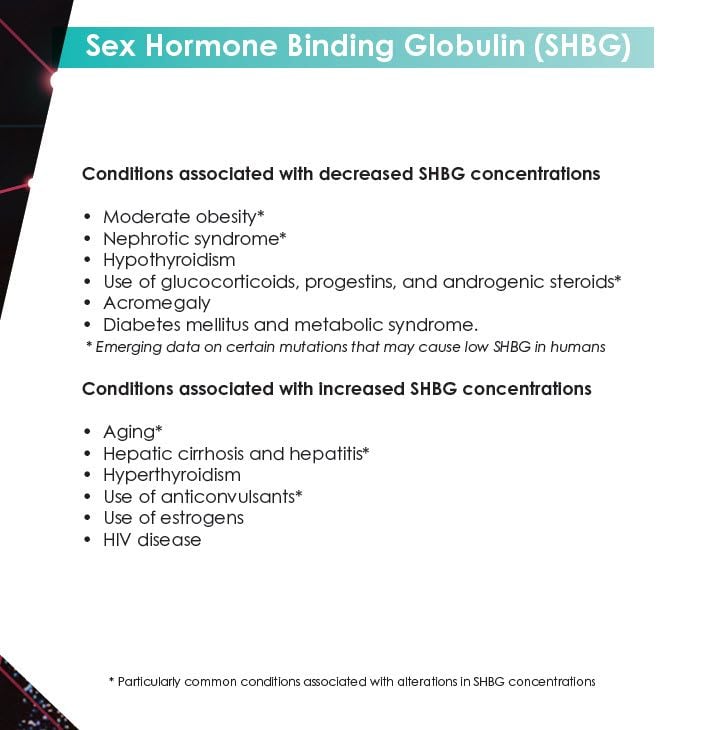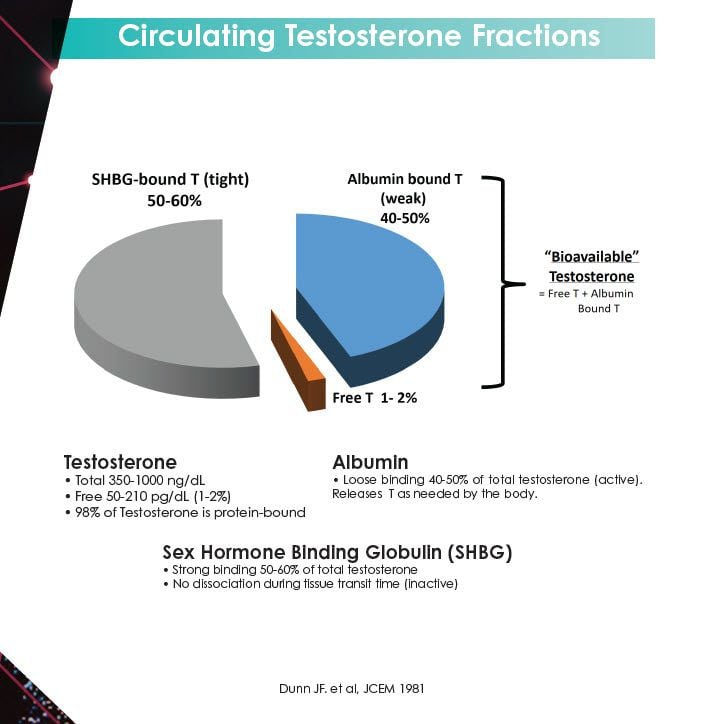Sex Hormone Binding Globulin - SHBG

SHBG (sex hormone binding globulin) binds to testosterone and estradiol. High SHBG may decrease free testosterone and free estradiol.
The Sex Hormone Binding Globulin (SHBG) test is a blood test that measures the amount of globulin in the body. SHBG is a protein that binds to sex hormones like testosterone and estrogen, which affects their availability in the body. The test is used to diagnose conditions related to hormone imbalances, such as polycystic ovary syndrome (PCOS) and hypogonadism. High levels of SHBG can lead to low levels of free testosterone or estrogen, while low levels of SHBG can result in high levels of free hormones. Understanding your SHBG levels can help your doctor determine the best course of treatment for your hormonal health.
Testosterone is the primary and dominant male hormone. It is responsible for numerous functions within the human body in men and women, and when levels are too low, it can lead to multiple health issues. Unfortunately, as many know, testosterone levels naturally decline as we age. Numerous external factors can contribute to lower levels of testosterone. In either case, age or external, symptoms occur, problems arise, and solutions are needed to stop the decline. For many men, testosterone replacement therapy (TRT) answers this problem. Men should ensure that their testosterone free and total, estradiol and other hormone factors are within normal levels. One of those hormone tests to monitor is the Sex Hormone Binding Globulin (SHBG) test.
Table of Contents
What is the SHBG Test?
Testosterone and estradiol circulate in the bloodstream, bound mostly to SHBG (sex hormone-binding globulin) and, to some degree, other blood proteins. Only a small fraction of the sex hormones are unbound, or "free," and thus biologically active and able to enter a cell and activate its receptor.
SHBG, or Sex Hormone-Binding Globulin, is a protein mainly produced in the liver that binds to sex hormones, such as testosterone and estrogen[1]. By binding to these hormones, SHBG helps control their release from the body's tissues into the bloodstream and also transports other substances in the blood, such as cholesterol, triglycerides, and thyroid hormones[3]. High SHBG can negatively impact athletic performance by reducing the bioavailability of testosterone, potentially hampering post-workout recovery[2]. Additionally, SHBG levels can be influenced by thyroid hormone and estrogen levels[5]. Changes in SHBG levels may also serve as an indicator of thyroid function, with low SHBG levels corresponding to low thyroid function and high SHBG levels indicating high thyroid function[4].
SHBG decreases the active form of the hormone available to the tissues. Thus bioavailability of sex hormones is influenced by the level of SHBG. High levels of insulin and androgens decrease SHBG levels. On the other hand, thyroid hormone and estrogen increase it.

When our body produces testosterone or provides it exogenously, a set level of testosterone flows through the body, ; thisestosterone blood level can be measured precisely through a simple blood test called the Total Testosterone blood test. For most adult men, when testing their total testosterone, if it falls in the 350 ng/dl to 1100 ng/dl range, this will be considered medically optimal. Such individuals, even exhibiting low testosterone symptoms, will often not be prescribed TRT. In some cases, this may be a correct diagnosis; in other cases, symptoms exist for different reasons, but in most cases, something else is at play, which makes SHBG important.
While useful, measuring total testosterone is only useful withalso measuring Free Testosterone. Free testosterone is a small fraction of your total testosterone. It is often referred to as "unbound," meaning the testosterone your body will use for its intended androgenic function. Free testosterone is so important that if your total testosterone levels are within range, if free testosterone levels are low, in most cases, the man will be symptomatic of low testosterone. This issue is often due to high levels of SHBG in the body.
For this reason, many men will attempt to lower their SHBG or even fret over it. However, SHBG serves an essential purpose. As is with estrogen, too much can be problematic, but so can too little. SHBG is no different.
Of all the testosterone flowing through your body, only 2% is what we can refer to as unbound or free testosterone. From a layman's perspective, one might think to increase free and unbound testosterone, all they'd need to do is increase their total testosterone. Unfortunately, it doesn't always work that way – it often helps and often fixes the issue but not always – and here's why: our testosterone is bound to albumin and sex hormone-binding globulin (SHBG). Approximately one-third of total testosterone binds to albumin, and the rest to SHBG.
Albumin is a protein that binds testosterone, and we can say it does so loosely. This protein carries testosterone through the bloodstream and releases it as needed. The testosterone detaches and becomes what's often referred to as bioavailable or free testosterone. The testosterone that separates from albumin becomes the testosterone that influences your body's functions from sex organs, muscle tissue, brain function, and a host of other areas of bodily function. Testosterone attached to SHBG cannot do this; it is attached and does not detach.

What Causes Low or High SHBG?
Conditions with low SHBG include ovarian cysts, diabetes, and hypothyroidism. Conditions with high SHBG include pregnancy, hyperthyroidism, and anorexia. Some medications, like anabolic steroids and high-dose testosterone, can reduce SHBG.
How to Lower SHBG Levels:
The most obvious answer to the problem of low free testosterone and high levels of SHBG is to increase testosterone. Exercise more, consume a cleaner diet, and lose weight; all of these things will increase your testosterone levels. Your levels may not increase massively, but some increase means a higher total to pull from and a greater amount of free testosterone based on the 2% fraction. If this isn't enough - perhaps you're not reaching a 2% fraction due to elevated SHBG – one may need to consider talking to their doctor about testosterone supplementation. However, even if supplementing with exogenous testosterone, the habits mentioned are good for overall health and can only have a positive impact.
Another possible solution, and one of the more commonly needed, is lowering estradiol levels in the body. We tend to think estrogen hormones are needed for females only, but they are also crucial for men, granted in smaller amounts. As it pertains to estrogen, too much estradiol can lead to elevated levels of SHBG. If testosterone levels are also low, this can lead to even more negative factors. But it's important not to get carried away as estradiol that's too low will bring numerous symptoms; your life could be miserable in that regard.
Many men who are at least somewhat familiar with testosterone have been wrongly told that too much testosterone can lead to gynecomastia due to elevated levels of estrogen in the body due to the aromatization of testosterone to estrogen. But low levels of testosterone in the body with present high levels of SHBG and estradiol can have the effect of causing gynecomastia. To combat high levels of estradiol, avoiding certain foods, especially soy-based ones, will be necessary. Equally important is living a healthy lifestyle and incorporating what was mentioned above: adequate exercise, a healthy diet, and getting enough sleep. These things will help lower estradiol. Some men will also need medical help through aromatase inhibitors if they have gynecomastia, although most men on TRT do not need an AI. Too many men have relied on aromatase inhibitors out of fear for too many years. In reality, most men who supplement with exogenous testosterone can, in fact, control estrogen via non-medicated factors.
Some studies have shown that supplementation with DHEA (Dehydroepiandrosterone) may also lower SHBG. However, more study is needed to understand this correctly, as too much DHEA can prove problematic. High doses of DHEA supplementation have been associated with increased estradiol, so you must speak to your doctor before starting such a supplementation regimen.
References:
[1] "SHBG is a protein mainly produced in the liver that binds to sex hormones. It mostly impacts the amount of testosterone your cells and tissue can use. An SHBG test offers your health care provider a better picture of your sex hormone levels than would just looking at your testosterone levels." URL: https://honehealth.com/edge/health/shbg-levels/
[2] "High SHBG can have a negative effect on your athletic performance, with reduced bioavailability of testosterone hampering your post-workout recovery. SHBG does not just affect the bioavailability of testosterone in your body. It also binds to all of your sex hormones, including estrogen." URL: https://malehealthreview.com/shbg-and-testosterone
[3] "Sex hormone-binding globulin (SHBG) is a protein that binds to the sex hormones testosterone and estrogen. Binding these hormones help control their release from the body's tissues into the bloodstream. SHBG also transports other substances in the blood such as cholesterol, triglycerides, and thyroid hormones." URL: https://fastr.org/shbg/
[4] "One final benefit of checking your SHBG level is it a good indicator of the thyroid function in your body. In states of low thyroid function, the SHBG level drops. In states of high thyroid function, the SHBG level rises. This allows the SHBG to be used as a marker to assess the thyroid hormone absorption and cellular function." URL: http://healthyhormones.us/shbg-test/
HOW DOES DISCOUNTEDLABS.COM WORK?
-
Go to the "Find a Location" page to find the closest lab location. No need to make an appointment since walk-ins are welcomed. Once you have identified your closest location, go to step 2.
-
Go to "Choose a Test" and add your selection (s) in the shopping cart. If you prefer to save money on bundled tests, we have created "Lab Test Panels" that can help you decide what to order.
-
If you have a discount coupon code, add it to your cart.
-
A $8 lab processing fee will be added to your total.
-
Pay using a credit card.
-
You will receive an order confirmation and instructions email on how to download your lab request.
-
Print lab request form that you downloaded.
-
Take that form to the closest location. Get your blood drawn.
-
You will receive an email when the results are ready for you to download.
Note: You cannot place an order under someone else's profile. The profile person's name will appear on the lab order form.If you have further questions, please email [email protected].
